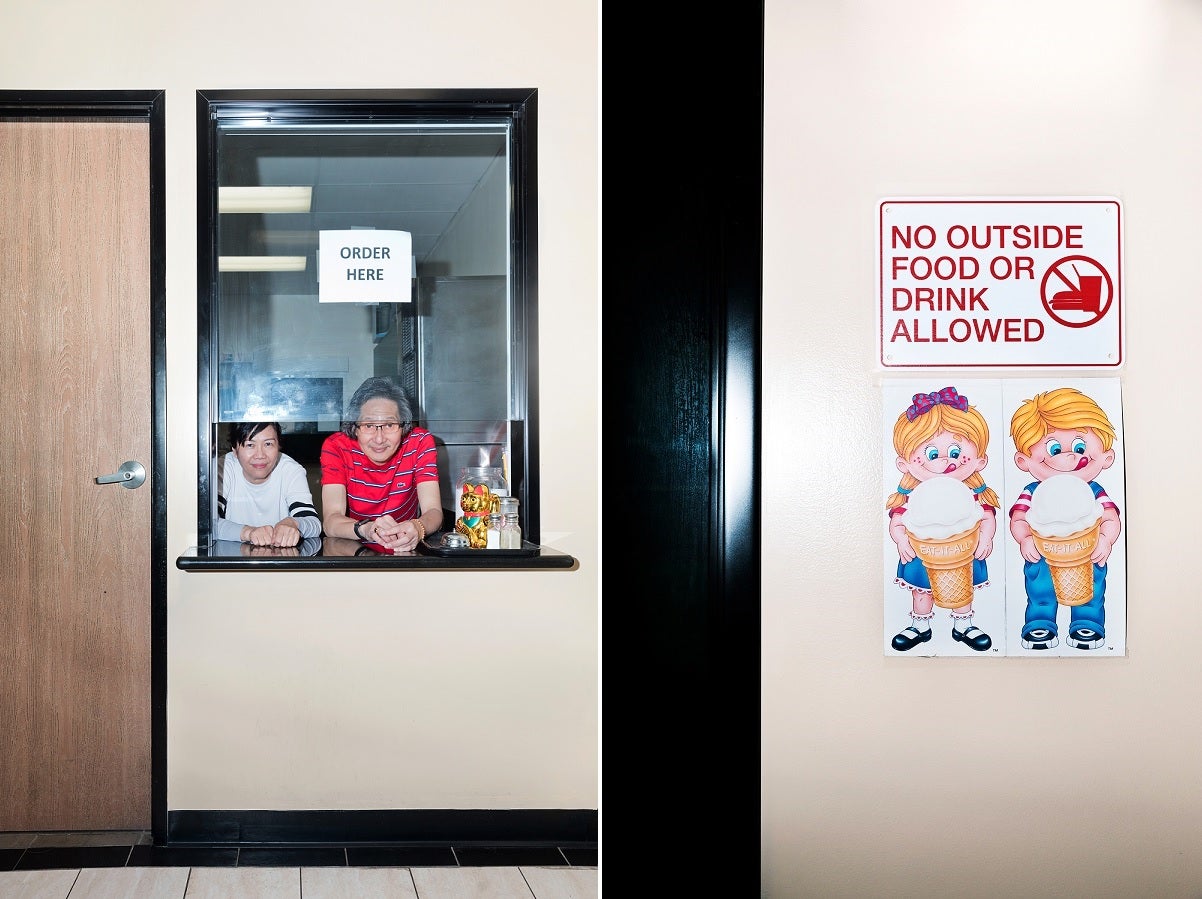Sumatran cuisine, with a side of shuttlecock, at the San Gabriel Valley Badminton Club.
Americans think of badminton as backyard leisure, but throughout Asia it is a big deal—badminton clubs are common and matches are constantly on TV. In that sense, it is the equivalent of football in America: Even if you don’t know the rules, you’ve watched it, intentionally or not, for most of your life. Badminton is a physically demanding sport, requiring sharp bursts of starting and stopping over an extended period of time. Which is to say, players need their nourishment. And at clubs across Indonesia, it is not uncommon for concessions to sell instant noodles, bubble teas, and candy to members.
Less common, however, are badminton cafés that serve full lunch and dinner menus; less common still are badminton cafés that do this in America. But on a recent Thursday afternoon, I found myself 31 miles east of Los Angeles, off the 210, to see one of them in person. A place called Cross Court Café was rumored to serve some of the best Indonesian food around from inside a 45,000-square-foot badminton complex.
The San Gabriel Valley Badminton Club in Pomona, California, sits across the street from a strip mall that includes a StateFarm Insurance office and a health clinic; on the horizon, the snow-capped Mount Baldy pulls your attention upward, momentarily, from suburban business, asphalt, and cars. SGVBC has 18 badminton courts, two volleyball courts, and a pro shop that sells rackets, duffel bags, and head-to-toe badminton attire (the shoes in particular stand out with gummy soles and flashy construction). Comparatively, the café—located just beyond the pro shop—is modest. It includes a smattering of wooden café tables, an order window decorated with a waving good-luck cat, wallpaper with a vintage image of a forest, and a couple of interior windows that peer onto badminton courts. The menu is printed on computer paper taped to the wall; no entrée costs more than $8.
In 2001, Angeline Go, her husband, Erman Chung, and their three daughters moved to California from Sumatra, Indonesia. Angeline’s youngest daughter started playing badminton at SGVBC, and in November 2015, after the failure of a previous on-site café—which sold Asian and American staples like wontons and fries—Angeline took over. The Cross Court Café’s weekday menu is simple: Chinese-style stir-fry noodles; Indonesian fried rice with sweet sausage, chicken, and a fried egg; pot stickers; wonton soup. But on weekends, Angeline prepares more elaborate specials—black pepper beef (nasi lemak), made with coconut milk and spicy rendang, for just one extra dollar. Angeline’s husband, Erman, is the beverage man and makes hot, cold, and bubble teas, fruit slushies, and smoothies.

Angeline Go, and her husband, Erman Chung, at the badminton club’s order window.
Unless you are a member of this club, however, you likely do not know Cross Court Café exists. A small electric sign, barely visible from the parking lot, reads “café” and flashes “open” intermittently. On the building façade, the words “Badminton Club, Academy & Cafe” appear, but there is no indication of what is served inside. There is no online presence outside of Yelp (God bless all you devoted Yelpers). “Their Indonesian fried rice and black pepper beef is phenomenal!!” (Five stars.) “My favorite is the bun with sticky rice, fatty pork, egg, mushroom…can eat that all day! (Five stars.) “The owners are the sweetest :-)” Another reviewer added that it reminded him of home. Suffice it to say, it seemed worth a trip.
I am not what you would call versed in Indonesian food, so my visit to the café was an education. Indonesia is an archipelago of some 6,000 inhabited islands (with thousands more uninhabited) situated between the Indian and Pacific Oceans, and across 735,400 square miles. Because its geography is so diverse and, in addition to Sumatra, includes the better-known islands of Java, Borneo, Bali, Timor, and New Guinea—so too is the breadth of its cuisine. And because Indonesia is located along historic trade routes, numerous seafaring countries have exported traditional dishes of their own to Indonesia. Think Chinese-style noodles and dumplings, Indian-derived curries, and even Dutch-influenced pancakes and pastries. Indonesian spices and marinades that are applied to poultry, beef, seafood, and vegetables are complex and may be salty, bitter, or sweet. Heat is common, too, from just a hint to a sweat-inducing wallop, and is often delivered via sambal, Indonesia’s traditional red chile sauce.
Rujak and oxtail soup from the cafe
At Cross Court, I sat next to Angeline, the café’s chef, at one of the wooden tables. She wore a pink Hilfiger sweatshirt, and her shiny black hair was pulled back neatly in a clip. Her oldest daughter, Chrisna, and her husband, Erman, sat next to us. These are Angeline’s secret weapons: self-described picky eaters who tell Angeline when something is off—what needs more salt, more heat, or, frankly, is not how they remember it tasting back home. When her family arrived in California, they missed the dishes from their home city, Medan. So Angeline—who had worked as a hairdresser in Sumatra—became a student in her own kitchen, with help from her mother and mother-in-law, and learned traditional Indonesian dishes to feed her family. I sipped a honey-sweetened green tea prepared by Erman, while Angeline explained that Sumatran cooking, like her family likes it, is often saltier and spicier than, say, Javanese cooking, which tends to be sweeter—think Sumatran rendang (heat-heavy beef curry) versus Javanese gudeg (with jackfruit, palm sugar, coconut milk, and chicken). This difference means that, in the U.S., Javanese-style Indonesian food is more common than Sumatran cooking; Indonesians know the American tongue is soft.
Beef satay and soto medan, a coconut milk-based chicken soup
With this in mind, Angeline offers me beef satay (common in Sumatra, where it is made with a spicy marinade) but with a sweet peanut sauce (common in Java). Skewered on sticks, the beef is soaked for two hours in a finely calibrated mix of spices that includes galangal, coconut milk, and brown sugar. The cut beef chunks are perfectly tender and finish with a crunch of fried shallots and a polite kick of chile. The skewered beef sticks hide a bed of cubed rice cakes. They are soft and disintegrate in my mouth like a snowball on a warm day; the experience is outstanding.
It is midday, and club members from places like the Philippines, South Korea, and China walk past the café carrying large duffel bags and dressed in elaborate outfits. Cries of victory and defeat, and the sound of screeching sneakers, carry into the café. Badminton originated in England in the middle of the 19th century and spread to Asia with English colonial rule. Today, the world’s top badminton talent often comes from China, Malaysia, and Indonesia. In 1992, the game that resembles tennis but replaces a ball with a shuttlecock made of a cork base and a 16-feathered cone became an Olympic sport.

Chrisna says she didn’t grow up playing badminton in Sumatra, but her dad played casually. She would tag along to his club, not because she enjoyed watching him, but because there was a café that served teas and sweet treats; Chrisna learned to love badminton for its snacks. When Chrisna’s younger sister, Carissa, started playing badminton more seriously at the club in Pomona, Angeline would accompany her daughter bearing home-cooked Indonesian dishes—rendang and dendeng, spicy, just like Sumatrans like it—and she brought extra to share with others. Angeline quickly became a popular presence at SGVBC.
While Angeline’s weekday menu is popular among players and nearby office workers—who have started to show up at lunchtime for boxes of quick and delicious Indonesian food to-go—the real time to visit Cross Court Café is on the weekends. It is then that you will catch Angeline’s specials that make the Yelpers rave—among other stunners, rendang and coconut rice served in individually wrapped bamboo leaves; she adds extra chile to bring Indonesian heat to the traditional Chinese preparation. I lament that I cannot try it for myself—it is only Thursday.
Angeline looks at me with a glint in her eye: “Sweet rice with bamboo leaf, I can do 500 [packets] in one day.” I tell her this efficiency is machine-like. “No,” she defers, then adds another skill. “I can cut six large packets of chicken in a half hour, in small pieces.” She smiles with pride and clarifies that it is boneless; still, the same task once took her two hours, she tells me.
Before I leave, Erman prepares a bubble tea to go, and Angeline, as if she can make time bend, emerges from the kitchen in moments clutching three to-go containers filled with stir fry, fried rice, fried popcorn chicken, and the rest of my beef satay. They are little packages of Sumatra that I would tuck carefully into my car, reopen in my home in L.A., and share with my roommates—who did not yet understand the splendor that awaited them from a badminton club in Pomona, California.